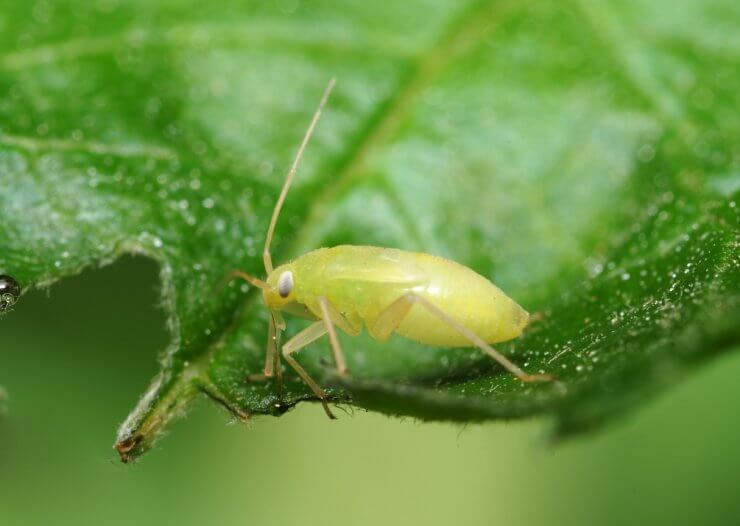
One of the benefits of growing herbs and vegetables in a hydroponic system is that you reduce the possibility of pests and diseases. Even still, there are a number of hydroponic pests and diseases that can wreak havoc on your veggies. Below are some common hydroponic pests and diseases and ways to prevent them from taking over your hydroponic system.
Discover the 3 top options for growing vegetables indoors—when you access the FREEBIE Growing Vegetables Indoors for Beginners, right now!
1. Aphids
Aphids can become hydroponic pests without you realizing it. At first, you may not notice them because they are so tiny. Full-grown aphids are about 1/8 of an inch big.
Signs to watch for: A colony of aphids will likely appear on new-growth stems and leaves. You may first notice discolored or wilting leaves. You may also notice ants that are attracted to the sugary residue left by the aphids.
Treatment: If you find your veggies are infested with aphids you can try to spray plants with neem oil or a soapy spray. A more Darwinian approach would be to introduce some ladybugs into your hydroponic environment since they are a natural predator to aphids. This is probably only a good option if your hydroponic garden is self-contained otherwise you may end up with a ladybug infestation!
Prevention: The best way to prevent aphids from becoming hydroponic pests is to not introduce them into your environment in the first place. Take caution when planting seedlings or transplanting plants that have been outdoors. Inspect your plants carefully before introducing them into your hydroponic garden.
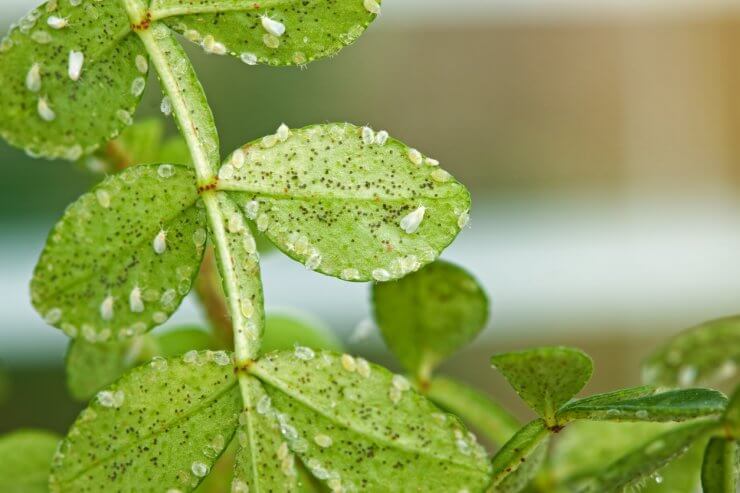
2. Whiteflies
Like aphids, whiteflies can become hydroponic pests, feeding on leaves and leaving a trail of sugary residue in their wake. Whiteflies can stunt the growth of vegetation as well as spread disease and other pathogens.
Signs to watch for: Whiteflies are tricky to spot since they are so small and often blend into their surroundings. They tend to hang out on the undersides of leaves and stems and are usually only spotted when they reach adult size. Leaf texture may become stickier due to whitefly residue and plants can become stunted, overall.
Treatment: Similar to aphid treatment, soapy sprays, and neem oil sprays are a good option. Before spraying, try to remove any active hydroponic pests with the wand attachment of a vacuum. Of course, take care to empty your vacuum in a way that doesn’t promote additional infestation. You can also introduce ladybugs and other predatory insects, though as mentioned above this is probably only a good idea if your hydroponic garden is in a greenhouse or other self-contained space.
Prevention: Sticky traps are a useful first line of defense and prevention for hydroponic pests like whiteflies. They’re a great tool to help you diagnose an issue before it becomes a full-on infestation. Neem oil is not only an effective treatment, it can also be used as a preventative addition to your hydroponic garden since it makes leaves and stems inhospitable to whiteflies.
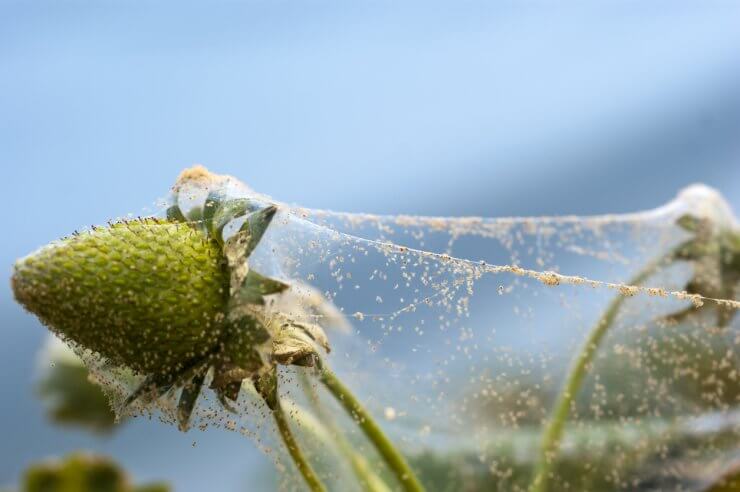
3. Spider mites
One of the most common hydroponic pests are spider mites. They can be tricky to get under control since they spread so quickly and they’re difficult to see.
Signs to watch for: The oval bodies of the spider mite are no bigger than the head of a pin. They can be green, yellow, tan, orange, and brown. You’ll know they’ve been around if you see yellow speckles on your veggie leaves. In larger infestations, you’ll notice webbing appears and leaves become brown.
Treatment: The standard treatment for spider mites is a miticide. For hydroponic pests, a miticide called azadirachtin can be added to your hydroponic reservoir at an approximate ratio of one tablespoon per gallon. (Follow directions on your particular bottle since concentrations can vary). As with all chemicals, take precautions when using azadirachtin and wear gloves, long sleeves, and closed-toe shoes. Wash your hands and any exposed skin immediately after use.
Prevention: Using sterile hydroponic equipment and plants is key to preventing spider mites. There are plant-friendly room cleaners and disinfectants that you can use in between growing cycles, to make sure you’re starting with a clean environment. Be careful when using cuttings from other people’s gardens. Inspect cuttings thoroughly and treat them with miticide before introducing them to your hydroponic system. Stay vigilant with your plants and use a magnifying glass periodically to inspect your hydroponic veggies.
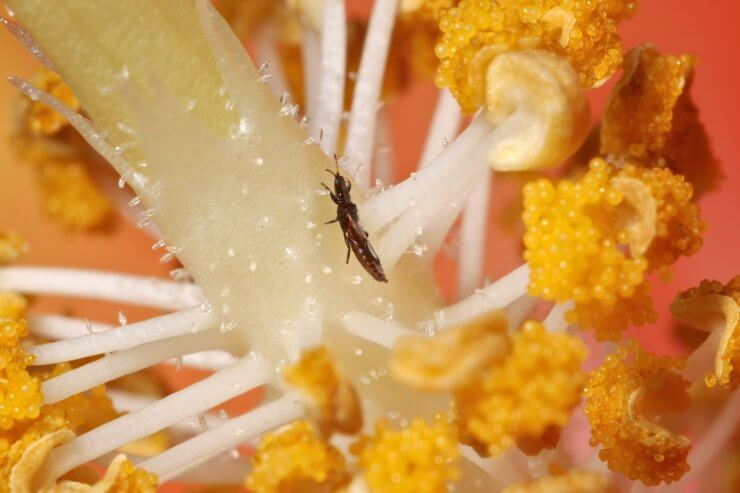
4. Thrips
Thrips are one of the sneakiest hydroponic pests out there since you may not notice them for months. They are small and slim, usually measuring about a millimeter in length. Thrips are either black or green with a small set of wings, though they aren’t good flyers. They often go undetected because they’re so fast-moving. Thrips can jump quickly from plants when gardeners get close to inspect leaves. In fact, gardeners often don’t see the pests themselves, rather the damage they leave in their wake.
Signs to watch for: Thrips scrape the surface of leaves and stems leaving behind a silvery appearance. In small numbers, the leaf damage is not a big problem and can be easily treated. But with a widespread thrip infestation, you won’t be able to keep up with the damage.
Treatment: Neem oil spray is a good option for treating thrips. The trick is to stay persistent since the spray will only kill adult thrips and pupa, not the eggs which are embedded in the leaf itself. Repeat sprayings will eventually kill off newly hatched thrips and you will be able to end the cycle as long as you stay vigilant.
Prevention: Using poly-plastic sheeting is a method for preventing these hydroponic pests. Cover the base of your hydroponics and root areas with plastic sheeting to prevent newly hatched thrips from burrowing into the roots. This helps prevent a full life cycle. There are also some natural predators you may choose to introduce like ladybugs and lacewings, but like the other methods for preventing hydroponic pests mentioned above, you’ll want to use predator insects in a controlled environment (and not, say, in your living room).
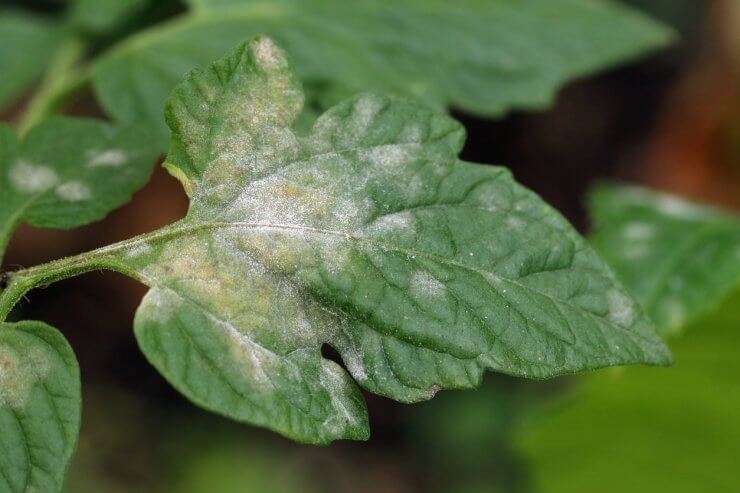
5. Powdery mildew/Downy mildew
Powdery mildew and downy mildew are both fungal infections that cause leaf damage to vegetable plants.
Signs to watch for: Powdery mildew gets its name from the visual pattern it makes on leaves, looking like spilled powder. Downy mildew on the other hand often develops on the underside of leaves and causes leaves to droop with yellow and brown spots.
Treatment: Fungicides are helpful treatments for different mildew diseases. There are also sulfur vaporizers that are beneficial with a large-scale infection. Though, be careful to follow instructions since improper usage can further damage your plants.
Prevention: Keep an eye on humidity levels. Anything over 60% increases your chances of a mildew infection. Avoid overcrowding your hydroponic plants. Mildews can spread rapidly among close touching leaves. Keep temperatures above 68 degrees. Cooler temperatures can be a breeding ground for these fungi.

6. Gray mold
Gray mold (also known as Botrytis), is another fungus that can affect hydroponic vegetables and herbs.
Signs to watch for: White to gray mold spreads rapidly on the surface, stems, and roots of plants. After infection, plants will turn brown and die.
Treatment: If you notice gray mold in your hydroponic system, remove the infected plant entirely to prevent the spread to additional plants. Dispose of the diseased plant far away from other vegetation.
Prevention: Equipment sterilization is important, especially if you use your garden tools indoors and outdoors. Like mildews, humidity is a major factor for gray mold and should be reduced.

7. Root Rot
Root Rot is tricky when it appears in your hydroponic system since the whole system relies heavily on water and root rot tends to appear when plants have been overwatered. What’s really at play is a lack of oxygen.
Signs to watch for: Yellowing leaves and droopy leaf positions are early signs of root rot. In addition, the roots themselves will brown and take on a slimy texture.
Treatment: Sadly, once the roots have turned brown, they’re beyond help.
Prevention: Make sure your hydroponic system includes methods for aerating the water, effectively. This can be accomplished using a mechanical oxygenator pump or even a low-tech air stone.
Common threads
There are common threads in dealing with and preventing the above hydroponic pests and diseases.
- Start off with a sterile environment and uninfected plants. Take time to carefully inspect your seedlings or plants before transferring them into your hydroponic system. Likewise, choose a sterilized growing medium with clearly labeled source information.
- Simple mitigation steps like passive sticky traps, are an excellent way to monitor your hydroponic system and make sure your vegetables and herbs remain healthy.
- When introducing chemicals like insecticides or fungicides to your hydroponic garden, do your homework. Read labels and consider how to keep your plants safe while also keeping them edible!
Do you have any tips for preventing hydroponic pests and diseases? What methods have you used? Let me know in the comments!
Discover the 3 top options for growing vegetables indoors—when you access the FREEBIE Growing Vegetables Indoors for Beginners, right now!


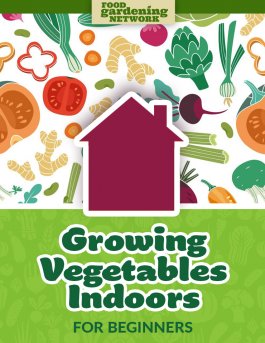


This is a terrific, valuable article, dear Amanda, I and many others will thank you as well. For years I never had any pest problems until my daughter brought me a beautiful bouquet of cut flowers from the outside world. Omg, in only a few days all of my growing units were covered with the worst aphid infestation I’ve ever.seen when I grew outside! They even left my office, and kitchen spaces and went all the way into the Foyer! I had to get rid of all I was growing and start all over again. It was too late for the Neem oil I keep handy. I suffered a big loss in produce that year and now I had to stop fresh flowers from my yard as well from coming in the house. This was also very sad for me because I love cut flowers so very much. Thank you once more for giving us such great and very helpful information in your articles. This one is of major importance for those of us who grow indoors. Thanks so much and Merry Christmas to you and family. Your true admirer,
Mo
Thanks for the great info on identification and problem solutions. Pictures were very helpful too!
Thought you might find this interesting